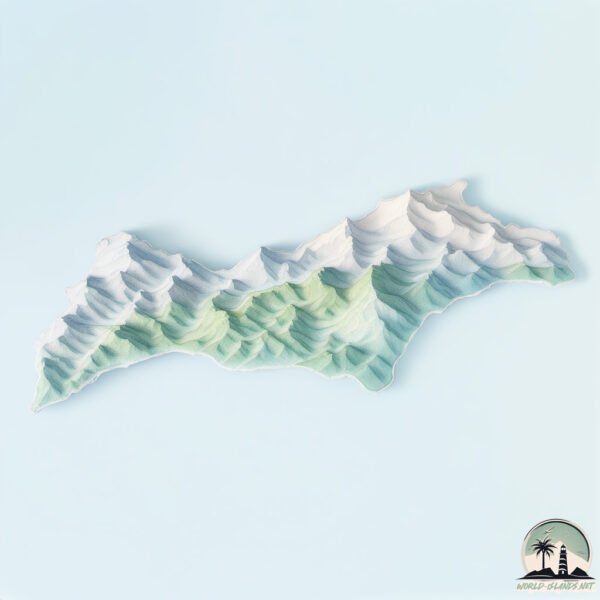Wetar

Welcome to Wetar, a Tropical island in the Banda Sea, part of the majestic Pacific Ocean. This guide offers a comprehensive overview of what makes Wetar unique – from its geography and climate to its population, infrastructure, and beyond. Dive into the details:
- Geography and Size: Explore the island’s size and location.
- Climate and Weather: Weather patterns and temperature.
- Topography and Nature: Uncover the natural wonders of the island.
- Infrastructure and Travelling: Insights on reaching, staying, and making the most of your visit.
- News and Headlines: Latest News.
Geography and size of Wetar
Size: 2633 km²
Coastline: 351 km
Ocean: Pacific Ocean
Sea: Banda Sea
Continent: Asia
Wetar is a Very Large Island spanning 2633 km² with a coastline of 351 km.
Archipel: Malay Archipelago – The world’s largest archipelago, located between mainland Southeast Asia and Australia, known for its immense biodiversity and cultural diversity.
Tectonic Plate: Timor – A small tectonic plate in the Timor region, primarily under the Timor Sea. It’s involved in the collision between the Australian and Eurasian plates, contributing to the region’s seismic activity and the uplift of the island of Timor.
The geographic heart of the island is pinpointed at these coordinates:
Latitude: -7.77943531 / Longitude: 126.30218066
Climate and weather of Wetar
Climate Zone: Tropical
Climate Details: Tropical Savanna, Wet
Temperature: Hot
Climate Characteristics: Defined by distinct wet and dry seasons with high temperatures year-round. Pronounced rainfall occurs during the wet season, while the dry season is marked by drought.
Topography and nature of Wetar
Timezone: UTC+09:00
Timezone places: Asia/Tokyo
Max. Elevation: 1311 m
Mean Elevation: 472 m
Vegetation: Evergreen Broadleaf Forest
Tree Coverage: 64%
The mean elevation is 472 m. The highest elevation on the island reaches approximately 1311 meters above sea level. The island is characterized by Mountains: High, steeply elevated landforms. Characterized by both a high maximum elevation (over 500 meters) and a high mean elevation, creating rugged, mountainous terrains on islands.
Dominating Vegetation: Evergreen Broadleaf Forest
Characterized by dense, lush canopies of broadleaf trees that retain their leaves year-round. These forests are typically found in tropical and subtropical regions and are known for their high biodiversity. Wetar has a tree cover of 64 %.
Vegetation: 13 vegetation zones – Exceptionally Diverse Island
Islands with more than ten vegetation zones are among the most ecologically rich and varied in the world. These islands are akin to miniature continents, boasting an incredible array of ecosystems. The sheer range of habitats, from high peaks to deep valleys, rainforests to deserts, creates a mosaic of life that is unparalleled. They are crucial for conservation and ecological studies.
Infrastructure and Travelling to Wetar
Does the island have a public airport? no.
There is no public and scheduled airport on Wetar. The nearest airport is Presidente Nicolau Lobato International Airport, located 66 km away.
Does the island have a major port? no.
There are no major ports on Wetar. The closest major port is DILI, approximately 62 km away.
The mean population of Wetar is 18 per km². Wetar is Gently Populated. The island belongs to Indonesia.
The name of the island resonates across different cultures and languages. Here is how it is known around the world: Arabic: جزيرة ويتار; German: Wetar; Spanish: Wetar; French: Wetar; Portuguese: Wetar; Russian: Ветар; Chinese: 韋塔島
Continuing your journey, Pulau Liran is the next notable island, situated merely km away.
Aerial Video of tropical, reef fringed Wetar island, Indonesia



Indonesia is classified as Emerging region: MIKT: Mexico, Indonesia, South Korea, and Turkey – Economies recognized for their development potential and emerging market status. The level of income is Lower middle income.
News – Latest Updates and Headlines from Wetar
Stay informed with the most recent news and important headlines from Wetar. Here’s a roundup of the latest developments.
Social Media Posts about Wetar
Please note: The data used here has been primarily extracted from satellite readings. Deviations from exact values may occur, particularly regarding the height of elevations and population density. Land area and coastline measurements refer to average values at mean high tide.
